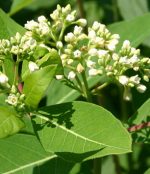 Also known as Indian hemp, this bushy herbaceous perennial is a member of the dogbane family, Apocynaceae, that also includes milkweed, periwinkle, and oleander. It is native to North America and grows in pastures, woodland edges, and ditches, and along roadsides throughout the US except in a band from northeastern Minnesota to central Montana. Plants like full sun to some shade and grow well in sandy to gravelly soil that is moderately moist and well-drained. Although poisonous to livestock, the toxicity of the plant to humans is not known.
Also known as Indian hemp, this bushy herbaceous perennial is a member of the dogbane family, Apocynaceae, that also includes milkweed, periwinkle, and oleander. It is native to North America and grows in pastures, woodland edges, and ditches, and along roadsides throughout the US except in a band from northeastern Minnesota to central Montana. Plants like full sun to some shade and grow well in sandy to gravelly soil that is moderately moist and well-drained. Although poisonous to livestock, the toxicity of the plant to humans is not known.
Description: Growing 2-6′ tall, hemp dogbane grows from a rhizomatous rootstock and has reddish, fibrous stems containing a milky latex that may cause dermatitis. The oval to elliptical leaves are 2 3/4 to 5″ long and have smooth margins and white hairs on the underside. The small whitish flowers are bell-shaped and and carried in clusters towards the tops of the stems in summer. The fruits are long narrow paired pods that contain numerous seeds with milkweed-like hairs. Plants spread by both seed sand rhizomes.
Control: Hoe or pull seedling till no more appear; pull, hoe, or dig older plants every few weeks until they stop sprouting. Alternatively , mow plants and cover the soil with a dense mulch such as newspaper or cardboard. Be sure that plants do not go to seed. Chemical control is difficult but a combination of herbicides including 2,4 D may suppress the weed. Roundup can be effective but will kill everything it touches.